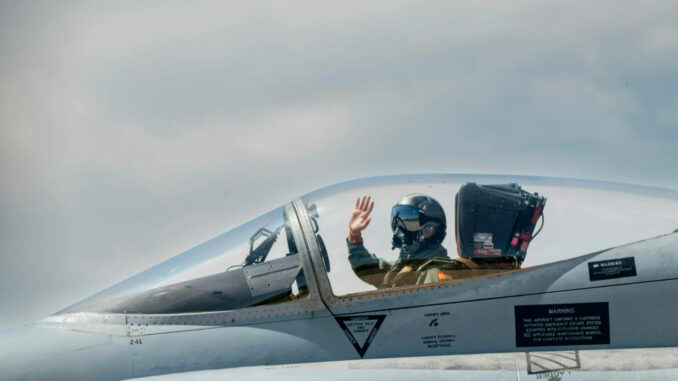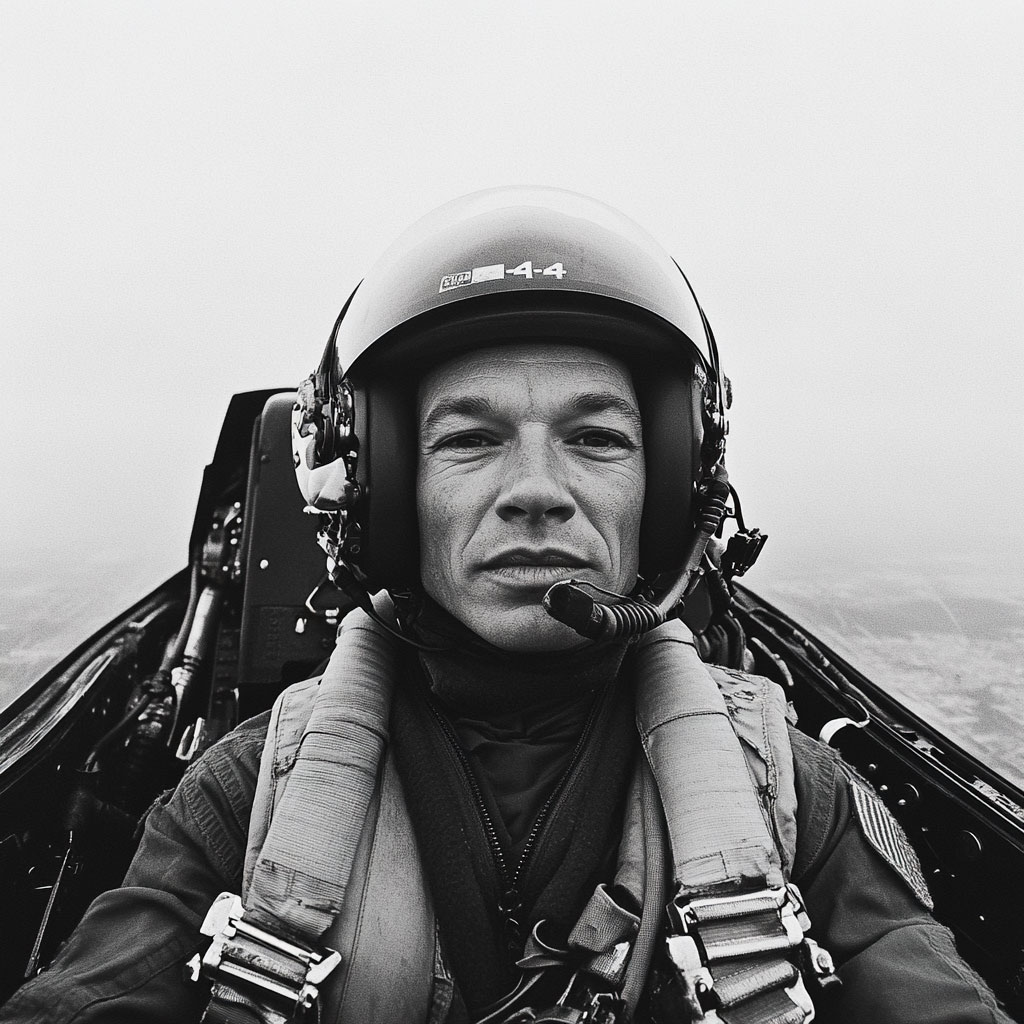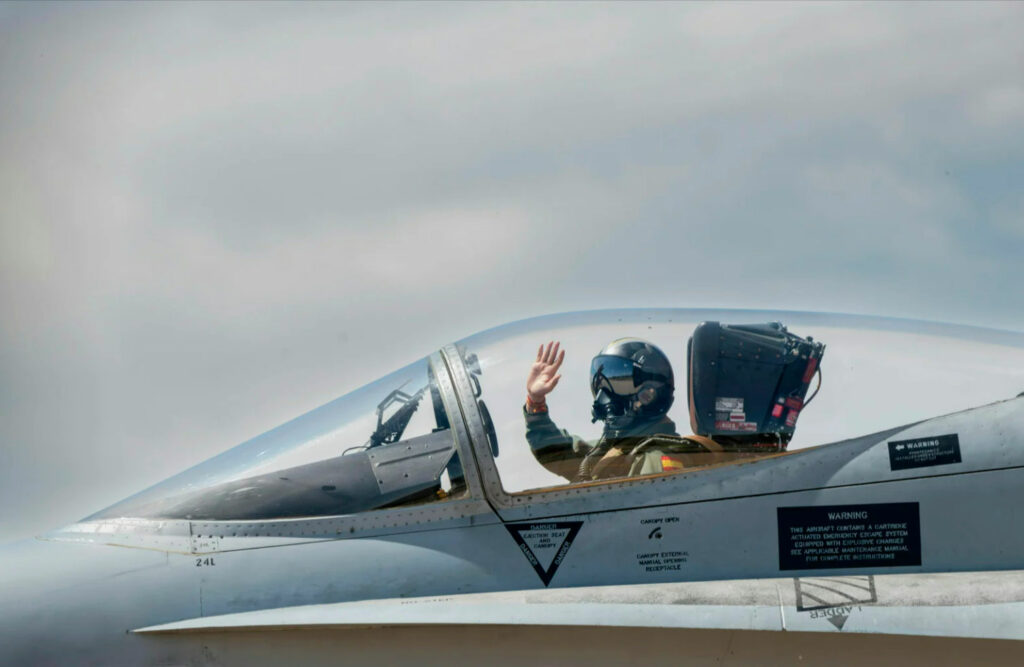
How fighter pilots withstand G-forces: techniques, physical limits, equipment, and long-term effects on health.
Why G-forces are a vital challenge for fighter pilots
In the context of combat aviation, G-forces represent the gravitational acceleration experienced by the human body during rapid maneuvers. A force of 1G corresponds to the normal gravitational pull at the Earth’s surface. When a pilot makes a tight turn, a rapid climb, or a high-speed loop, they can experience accelerations of +6G to +9G, or even more in some modern fighter jets such as the F-16 or the Rafale. This means that their body, head, and even their blood become up to nine times heavier than at rest.
These accelerations generate critical physiological effects. Under the effect of positive G-force (+Gz), blood is pushed down toward the lower body, away from the brain. This causes a gradual loss of peripheral vision (grey-out), followed by total blackout. If the maneuver continues without effective countermeasures, the pilot may experience G-LOC (G-induced Loss Of Consciousness), i.e., a sudden loss of consciousness lasting an average of 12 to 20 seconds. During this time, the pilot loses control of the aircraft, which can lead to a crash, especially at low altitudes or in combat situations.
Sensory disturbances also include dizziness, temporary disorientation, and loss of muscle control. Despite technological advances, the human ability to withstand G-forces remains a limiting factor in the design of fighter aircraft. While modern machines can withstand loads of more than 9G, humans remain the weakest link. This is why the armed forces invest in intensive training programs, anti-G equipment, and advanced medical research to push physiological limits without compromising pilot safety.

What the human body experiences beyond 6G
When fighter pilots are subjected to acceleration greater than 6G, the physiological balance of the human body is profoundly disrupted. Under the effect of positive longitudinal G-force (+Gz), blood is mechanically displaced toward the lower extremities, particularly the legs and abdomen. This displacement causes cerebral hypoperfusion: blood flow to the brain decreases sharply, reducing the supply of oxygen to the nerve cells.
The first consequences appear in the visual field. The pilot gradually loses peripheral vision, a phenomenon known as “grey-out”. If the acceleration continues, vision narrows into a tunnel effect, until complete loss of vision (“blackout”). If there is no immediate reaction, this can lead to G-LOC (G-induced Loss Of Consciousness), a loss of consciousness caused by insufficient oxygen in the cerebral cortex. G-LOC can last between 12 and 30 seconds, with partial recovery of motor and cognitive control taking up to 60 seconds, during which time the pilot is unable to maneuver the aircraft.
The autonomic nervous system also comes into play to try to maintain cerebral perfusion: the heart rate increases, blood vessels constrict (vasoconstriction), and blood pressure is actively regulated. However, these natural mechanisms have their limits when faced with continuous mechanical loads.
In an untrained person, loss of consciousness can occur at sustained 4 to 5G. On the other hand, a seasoned fighter pilot, trained in a centrifuge and using the right countermeasures, can tolerate up to +9G for 10 to 15 seconds, or even longer. This ability depends on physical condition, mastery of breathing techniques, and the proper functioning of anti-G equipment.
Physical and respiratory training to combat G-forces
To effectively withstand high accelerations, fighter pilots rely on a specific technique: the anti-G maneuver, known as AGSM (Anti-G Straining Maneuver). This method aims to prevent blood from leaving the brain by artificially maintaining sufficient blood pressure during phases of high acceleration. AGSM combines two essential elements: targeted muscle contraction and controlled fractionated breathing.
In practical terms, the pilot performs intense isometric contractions of the leg, gluteal, and abdominal muscles. This muscle tension closes the blood vessels in the lower body, limiting the flow of blood to the extremities. At the same time, the driver breathes rhythmically: they inhale quickly, hold the air in their lungs, then exhale in a controlled manner approximately every 3 seconds. This temporary blockage raises the pressure in the chest, artificially increasing blood pressure to the brain.
The effectiveness of AGSM relies largely on the pilot’s muscle strength and endurance. This is why physical training programs emphasize strengthening the quadriceps, glutes, lower back, and abdominals, which are the muscles most used under G-forces. Specific exercises, performed in a seated or semi-seated position, replicate the efforts made in the cockpit.
AGSM is learned in a human centrifuge, a device that simulates progressive G-forces in a controlled environment. Pilots are exposed to levels ranging from +6G to +9G, sometimes with rapid acceleration to test their responsiveness. They learn to recognize their personal physiological limits, detect the first signs of vision loss, and react immediately.
Finally, a key factor in G-force resistance is the ability to concentrate under stress. The brain must remain alert, able to process bodily signals quickly and execute countermeasures without delay. This cognitive hypervigilance is maintained through simulations, real missions, and ongoing mental conditioning. Because when faced with G-forces, reflexes become a matter of survival.
Anti-G suits: principles and limitations
In addition to muscle and respiratory training, fighter pilots use anti-G suits designed to limit blood flow to the lower limbs during high-acceleration maneuvers. These suits are made of resistant materials and equipped with segmented inflatable chambers, located mainly around the legs, thighs, and abdomen.
They work using a pneumatic system integrated into the aircraft. When on-board sensors detect acceleration above a predefined threshold (often around +4G), compressed air is automatically sent into the suit’s chambers. These pockets inflate in a matter of milliseconds, exerting mechanical pressure on the lower limbs and abdomen. This pressure prevents blood from pooling in these areas, maintaining circulation to the brain and thus reducing the risk of G-LOC.
Several models are in service depending on the country and type of aircraft. In the United States, the CSU-13B/P is used in aircraft such as the F-16 and F-15. This model is compatible with the COMBAT EDGE integrated survival system, which combines the anti-G suit with a positive pressure oxygen mask. In Europe, versions derived from the Libelle G-suit or British pressurized suits are used on the Eurofighter Typhoon and Rafale.
However, this equipment has technical and physiological limitations. The pressure exerted is partial and does not replace the AGSM. Its effectiveness also depends on precise adjustment to the pilot’s body type. In the event of an air leak or compressor failure, the system may be ineffective in flight, with immediate consequences. In addition, prolonged wear can cause discomfort, muscle pain, or respiratory distress. These constraints must be compensated for by the pilot constantly adapting to their equipment.
Why training is not always enough
Despite months of intensive training and the use of advanced anti-G suits, experienced fighter pilots remain vulnerable to the effects of G-forces. Several aggravating factors can compromise their ability to withstand extreme acceleration.
Physical and mental fatigue is one of the primary risks. A combat or training flight often lasts several hours, requiring constant vigilance. This wear and tear weakens the body’s ability to perform AGSM maneuvers correctly. Similarly, mild dehydration or insufficient food intake can reduce blood volume, thereby decreasing the body’s ability to maintain adequate blood pressure. Hypoxia, caused by high altitude or oxygen mask malfunction, can exacerbate loss of consciousness by further reducing oxygenation of the brain.
One of the most critical issues is the reaction time to the first symptoms. Between the onset of tunnel vision and blackout, sometimes less than a second elapses. A pilot who is inattentive, distracted, or overly focused on a secondary task may react too late, rendering the AGSM maneuver ineffective. Even a minor error in execution—poor coordination between muscle contraction and breathing—is enough to allow blood to flow to the legs and cause G-LOC.
Testimonials from experienced pilots confirm that this type of incident is not uncommon. American, British, and French pilots have reported losing consciousness despite their experience and physical condition. In several cases, it was onboard safety systems (autopilot, sufficient altitude) that prevented a crash. These events serve as a reminder that even the best-trained pilots are exposed to an extremely small margin for error in an environment where every second is critical.

Long-term effects on pilots’ health
Repeated exposure to accelerations greater than 6 or 7G leaves lasting effects on the bodies of fighter pilots, even in the absence of acute incidents. The physiological effects are not limited to the moment of flight: they can cause chronic injuries, particularly to the musculoskeletal and neurovestibular systems.
The most affected areas are the cervical and lumbar regions. During a +9G turn, the pilot’s head, including the helmet, can weigh more than 70 kg. This repeated mechanical stress leads to disc herniation, vertebral protrusions, or chronic pain in the long term. Studies by the US Air Force (USAF) and NATO have shown a high prevalence of disabling cervical disorders among fighter pilots with 10 or more years of active service.
The vestibular system, located in the inner ear, is also affected by rapid changes in acceleration. In the long term, this can disrupt balance and coordination. Some pilots report episodes of recurrent dizziness, disorientation, or nausea, even on the ground.
More recent research is looking at neurocognitive disorders linked to intermittent hypoxia and microtrauma to the brain. Although data is still limited, some military doctors have reported an increased risk of memory and concentration problems and slower reaction times in former elite pilots.
Longitudinal studies conducted by NASA, the US Navy, and the Bundeswehr have identified early markers of disc degeneration and neurovestibular disorders in retired pilots. This research highlights the need for long-term specialized medical monitoring, including imaging, rehabilitation, and prevention. Despite their excellent physical condition, pilots continue to experience accelerated aging of certain bodily systems, directly linked to the operational load of G-forces experienced in flight.
Pilots of the future
In modern combat aviation, the human factor remains central, even in the face of increasingly advanced technologies. Today’s fighter jets can withstand loads of more than 9G, but the pilot’s body remains the main operational limitation. Despite the support of anti-G suits, life support systems, and high-precision simulators, only a precise control of one’s own body, acquired through intensive training, allows pilots to fly effectively in high-stress environments.
In the future, air forces are exploring new solutions: artificial intelligence to assist piloting, partially or fully autonomous aircraft, exoskeletons to reinforce muscle support, and onboard biological sensors to monitor vital functions in real time. These tools will not replace pilots, but will aim to extend their performance and reduce the physiological risks associated with extreme maneuvers. Air warfare remains, above all, a battle between human limits and mechanical power.
War Wings Daily is an independant magazine.